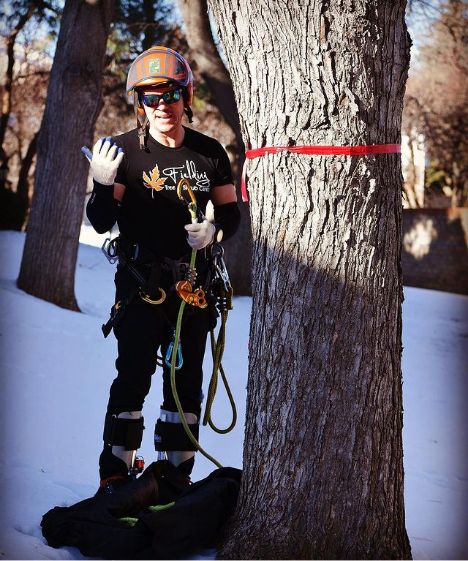Trees are a beautiful and vital part of any landscape, providing shade, clean air, and natural beauty. However, trees can also pose serious hazards if they become unstable.
Whether it’s due to disease, damage, or structural weaknesses, a falling tree can cause injury, property damage, or even death. Recognizing the warning signs early on is crucial, not only to protect your property but to keep your family and neighbors safe.
Let’s explore the key indicators that a tree might be at risk of falling, what you can do to mitigate the danger, and when it’s time to call a professional tree service to assess the situation.
Why Trees Fall: The Most Common Causes
Before we dive into the warning signs, it’s helpful to understand why trees fall in the first place. Here are some of the most common causes…
Root Damage or Decay
Roots are the foundation of any tree. If they’re damaged, by construction, root rot, or compacted soil, the tree may lose its structural support and become unstable.
Disease and Pests
Fungal infections like root rot or wood decay, and pests such as borers and beetles, can weaken a tree from the inside out. By the time you notice external symptoms, the internal structure may already be compromised.
Soil Erosion or Saturation
Heavy rains or flooding can wash away the soil around a tree’s base, exposing roots and making the tree more likely to topple.
Severe Weather
Strong winds, lightning, snowstorms, or drought can all cause physical damage to trees, especially those already weakened by other factors.
Improper Pruning or Neglect
When trees are improperly pruned or never maintained at all, they may develop structural imbalances that make them more likely to fall.
10 Warning Signs a Tree May Be at Risk of Falling
So how do you know if a tree is on the verge of falling? Here are 10 red flags to look for…
1. Leaning Tree
A slight lean can be natural, but a sudden or increasing lean may signal trouble. Trees leaning more than 15 degrees from vertical, especially with cracked soil on the leaning side, are likely unstable and at high risk of falling.
2. Cracks in the Trunk or Major Limbs
Large vertical cracks, splits, or cavities in the trunk or major limbs indicate internal decay or structural failure. These weaknesses can cause the tree to snap under pressure.
3. Dead or Falling Branches
Deadwood is often a precursor to larger problems. If large branches are dying or dropping without cause, the tree may be in decline and vulnerable to falling.
4. Fungus at the Base
The presence of mushrooms or fungal conks at the tree’s base or on the trunk is a sign of internal rot. While not all fungi are harmful, many are indicators of wood decay and structural weakening.
5. Exposed or Damaged Roots
Roots that are visibly decaying, cracked, or exposed due to erosion may no longer provide adequate support. Construction near trees is another common cause of root damage.
6. Hollow or Soft Spots
If the trunk sounds hollow when tapped or feels soft in places, the tree may be rotting from within. A hollow tree trunk can still stand, but it’s far more likely to fall in a storm.
7. Canopy Dieback
Canopy dieback occurs when the top of the tree or ends of branches lose foliage and don’t regrow leaves. This usually indicates that the tree is stressed or dying.
8. Insect Infestations
Pests like bark beetles and emerald ash borers can infest and weaken a tree. Look for small holes in the bark, sawdust around the base, or increased woodpecker activity.
9. Soil Heaving Around the Base
If you notice the soil lifting, cracking, or mounding around the base of the tree (especially after a storm) that’s a strong indicator that the root plate is moving and the tree may fall soon.
10. Multiple Trunks (Codominant Stems)
Trees with multiple large trunks stemming from the same spot can be prone to splitting, especially if there’s a weak connection or included bark between them.
What to Do if You Suspect a Tree Is Unstable
If you observe one or more of these warning signs, it’s important not to ignore them. Here are the steps you should take:
Keep a Safe Distance
Until a tree can be evaluated by a professional, it’s best to keep people and pets away from the area around the tree, especially during high winds or storms.
Document the Signs
Take clear photos of any visible issues like leaning, cracks, dead branches, or exposed roots. This documentation can be helpful for insurance purposes or when consulting a tree service professional.
Call a Professional Tree Service
Evaluating the risk level of a potentially hazardous tree should always be done by a certified arborist. They have the expertise, tools, and safety equipment needed to assess whether the tree can be saved, or if removal is the safest course of action.
Can a Risky Tree Be Saved?
Not every problem means a tree must be removed. In some cases, a tree service may recommend:
- Cabling or Bracing: Installing support systems to reinforce weak branches or trunks.
- Selective Pruning: Removing dead or structurally unsound branches to redistribute weight.
- Soil or Root Treatment: Improving drainage, reducing compaction, or treating pests and diseases.
- Fertilization and Watering: Boosting the tree’s health to help it recover naturally.
However, if the tree poses an imminent threat to people, structures, or utility lines, removal may be the only responsible choice.
The Importance of Regular Tree Inspections
The best way to avoid emergencies is with proactive tree care. Having your trees inspected annually by a certified tree service professional can help identify early warning signs before they become dangerous. Regular maintenance like pruning, pest control, and soil management will not only improve safety but also help your trees thrive for decades to come.
When Should You Remove a Tree?
While it’s always preferable to save a tree when possible, removal is sometimes the safest and most cost-effective option. Consider removing a tree if:
- It’s leaning dangerously toward a home, sidewalk, or power line
- More than 50% of the canopy or trunk is damaged or decayed
- Major roots are severely damaged or exposed
- The tree has been declared hazardous by a certified arborist
Removing a tree can be emotionally difficult, especially if it’s old or part of your landscape’s character. But safety should always come first, and you can always replant a healthy new tree in its place.
Final Thoughts
Tree failures can be catastrophic, but the good news is they’re often preventable with early detection and proper care. By staying aware of the warning signs like leaning, cracking, fungus, or canopy dieback, you can catch problems early and work with a trusted tree service to address them.
At Fielding Tree Care, we’re passionate about preserving the health and safety of your trees and property. Our certified arborists are trained to assess, diagnose, and resolve tree issues using the most effective and environmentally friendly techniques.
If you’re concerned about a tree on your property, don’t wait for it to become a bigger problem. Contact Fielding Tree Care today for an expert Denver tree service that homeowners trust.






